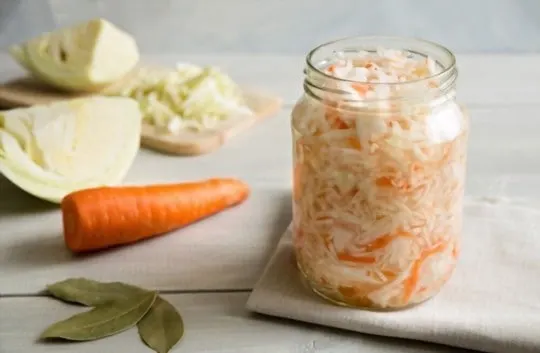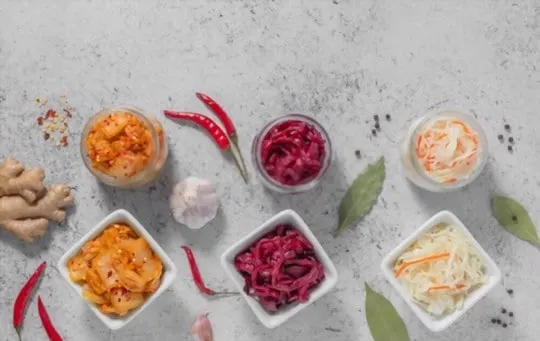While Westerners may not realize it, they’ve been eating kimchi and sauerkraut for centuries; different names call them.
Both of these foods are fermented vegetables and are generally considered beneficial both to health and taste.
However, there is a huge difference between the two: while kimchi is spicy-hot, sauerkraut is mild, tangy, and sweet.
This article will take a closer look at these two fermented vegetables, reviewing their origin and taste, health benefits, and recipes.
What is Kimchi?

It is a spicy-hot fermented cabbage dish from Korea.
Kimchi has been around for about 2000 years.
In the beginning, different regions of Korea made kimchi with different ingredients (cabbages, radishes, cucumbers), but over time the recipe converged into one spicy-hot version.
Today it is probably Korea’s most famous dish and its national cuisine.
The vegetables are mixed with garlic, ginger, onion or scallions, salt, fish sauce or shrimp sauce, chili pepper, and various spices.
The mix is then left to ferment for several days or even weeks.
Finally, kimchi is ready to eat.
It can be served as an appetizer, side dish, or main course.
Kimchi has a strong taste of spicy-hot, sour, salty, and sweet.
What is Sauerkraut?

Sauerkraut is a fermented cabbage dish from Germany.
It has been eaten for at least 1000 years.
The origin of the name SAUERKRAUT comes from the German verb “sauern”, which means to sour.
It is made by finely chopping raw cabbage and salt and leaving it to ferment for several weeks.
Once the fermentation period is over, sauerkraut can be eaten.
It has a strong taste that is tangy, salty, and sweet.
When done well, sauerkraut is one of the most delicious fermented foods.
Sauerkraut is usually eaten raw, but it can also be cooked or added to various dishes.
It has a long shelf-life due to its high acidity level.
However, too much salt will cause the cells of the cabbage slices to burst so that the dish will spoil rapidly.
In addition to being a wonderful side dish, sauerkraut can be used in various recipes, from salads and soups to stews and sauces.
Nutrition Content – Kimchi Vs Sauerkraut

As we saw, kimchi and sauerkraut are both fermented vegetables.
They have a long tradition in Eastern European and Asian cuisine.
They are very low in calories and rich in dietary fiber, antioxidants, and probiotics.
The protein and vitamin content are also good as the vegetables used to make these dishes are nutritious.
But there are some minor differences.
The protein content is slightly lower in sauerkraut than kimchi, mostly because of the higher proportion of other vegetables used for sauerkraut.
Sauerkraut also contains more vitamin A, calcium, and iron.
This is due to the generous amount of cabbage used in sauerkraut, while kimchi uses other vegetables like leek or garlic.
However, it is worth noting that both vegetables are very low in carbohydrates, which makes them a great addition for anyone on a ketogenic diet.
Fermentation Process for Kimchi and Sauerkraut
As mentioned previously, both kimchi and sauerkraut are fermented vegetables.
So how exactly do they ferment?
For fermentation to occur, there must be a sugar source for the bacteria and yeast to feed on.
Since we don’t use sugar in these recipes, we rely on the vegetables themselves.
They contain natural sugars that get converted into lactic acid during fermentation.
The fermentation of vegetables is a complex biochemical process that involves decomposition and metabolism.
It starts with bacteria breaking down carbohydrates, which produce carbon dioxide, hydrogen, organic acids, and other byproducts.
Then, yeast takes over and continues converting sugars into alcohol.
This creates a more acidic environment.
Finally, lactic acid bacteria convert the alcohol into lactic acid, which preserves the vegetables.
These interactions between microorganisms give fermented foods their distinct taste and texture.
Kimchi fermentation happens at room temperature (18-25 °C) for about 1 or 2 days, while sauerkraut ferments in a cold environment (5-10 °C) for about 3 to 4 weeks.
If that doesn’t sound appealing to you, remember that you can start the fermentation process in a jar and put it in the fridge.
There, the fermentation will slow down significantly.
In this case, fermentation may take longer than four weeks, but it’s still far from a lengthy process which is why many people choose to do it at room temperature anyways.
What’s the Difference Between Kimchi and Sauerkraut?

Since kimchi and sauerkraut are fermented vegetables, they have many.
But there still is a difference.
Kimchi has more vegetables than cabbage, such as carrots and daikon radish, while sauerkraut typically contains cabbage and salt.
Kimchi also uses red pepper, garlic, and ginger, while sauerkraut does not.
And, of course, the taste is different due to the spices used in each recipe.
Origins also play a role in what sets sauerkraut and kimchi apart.
While kimchi was traditionally made in Korea, sauerkraut is of German origin.
As such, it’s typically paired with sausage or pork, while kimchi often accompanies rice and other types of meat like beef or chicken.
When it comes to the fermentation process, kimchi begins fermenting at room temperature while sauerkraut ferments in a cold environment.
Regarding the cabbage consistency, kimchi leaves the cabbage pretty chunky while sauerkraut shreds it.
Conclusion
Overall though, kimchi and sauerkraut are very similar.
They’re both fermented vegetables with long histories and nutritional benefits.
While they don’t taste the same, they’re both great accompaniments to any meal.
However, they do have some differences, like the vegetables used and the fermentation environment.
But, in general, their taste is very similar, while their health benefits are pretty much the same.
Plus, they taste really good.
So give these recipes a try yourself and see how you like them.
